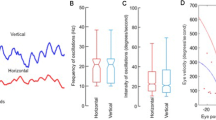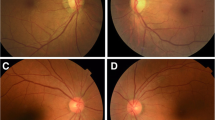Abstract
Convergent strabismus is a common diagnosis in early childhood, when it is mostly considered benign. If it develops later in life, strabismus can, however, be a sign of neurological disease. In these cases the underlying pathophysiological mechanisms are largely unknown. In this retrospective case–control study we analyzed the neuro-ophthalmological examination reports of 400 adult patients who presented at the German Center for Vertigo and Balance Disorders to determine an association between ocular misalignment and cerebellar dysfunction. Patients with cerebellar signs (i.e., cerebellar ataxia and/or cerebellar ocular motor signs) had a 4.49 (95 % CI [1.60; 13.78]) times higher frequency of ocular misalignment and specifically a 13.3 (95 % CI [3.80; 55.73]) times increased frequency of esophoria/esotropia (ESO) during distant gaze than patients without cerebellar dysfunction. ESO when looking into the distance was associated with saccadic smooth pursuit, dysmetria of saccades, and downbeat nystagmus (DBN) (χ 2 test, p < 0.0001 for all associations). Patients with cerebellar dysfunction also showed mildly impaired eye abduction (χ 2 test, left eye and right eye: p < 0.0001), associated with horizontal gaze-evoked nystagmus (χ 2 test, p < 0.0001). The association of ESO and DBN implicates a pathophysiological involvement of the cerebellar flocculus, while the association with dysmetric saccades suggests involvement of the oculomotor vermis. This is compatible with animal studies showing that the pathways of the flocculus/posterior interposed nucleus and vermis/nucleus fastigii are both involved in vergence movements and static binocular alignment. From a clinical point of view, a newly diagnosed esophoria/esotropia only during distant gaze may be a sign of a cerebellar disease.

Similar content being viewed by others
References
Anderson WD, Lubow M (1970) Astrocytoma of the corpus callosum presenting with acute comitant esotropia. Am J Ophthalmol 69:594–598
Baier B, Bense S, Dieterich M (2008) Are signs of ocular tilt reaction in patients with cerebellar lesions mediated by the dentate nucleus? Brain 131:1445–1454
Balaban CD, Watanabe E (1984) Functional representation of eye movements in the flocculus of monkeys (Macaca fuscata). Neurosci Lett 49:199–205
Buttner-Ennever JA (1999) A review of otolith pathways to brainstem and cerebellum. Ann N Y Acad Sci 871:51–64
Chaudhuri Z, Demer JL (2013) Divergence insufficiency esotropia is a misnomer-reply. JAMA Ophthalmol 131:547–548
Das VE (2012) Responses of cells in the midbrain near-response area in monkeys with strabismus. Invest Ophthalmol Vis Sci 53:3858–3864
Dufosse M, Ito M, Miyashita Y (1977) Functional localization in the rabbit’s cerebellar flocculus determined in relationship with eye movements. Neurosci Lett 5:273–277
Defoort-Dhellemmes S, Denion E, Arndt CF, Bouvet-Drumare I, Hache JC, Dhellemmes P (2002) Resolution of acute acquired comitant esotropia after suboccipital decompression for Chiari I malformation. Am J Ophthalmol 133:723–725
Gomez CR, Gomez SM, Selhorst JB (1988) Acute thalamic esotropia. Neurology 38:1759–1762
Graham PA (1974) Epidemiology of strabismus. Br J Ophthalmol 58:224–231
Hain TC, Luebke AE (1990) Phoria adaptation in patients with cerebellar dysfunction. Invest Ophthalmol Vis Sci 31:1394–1397
Holmes G (2007) The Croonian Lectures on the clinical symptoms of cerebellar disease and their interpretation. Lecture II. 1922. Cerebellum 6:148–153
Hoyt CS, Good WV (1995) Acute onset concomitant esotropia: when is it a sign of serious neurological disease? Br J Ophthalmol 79:498–501
Hufner K, Barresi D, Glaser M, Linn J, Adrion C, Mansmann U, Brandt T, Strupp M (2008) Vestibular paroxysmia: diagnostic features and medical treatment. Neurology 71:1006–1014
Ito M, Nisimaru N, Yamamoto M (1977) Specific patterns of neuronal connexions involved in the control of the rabbit’s vestibulo-ocular reflexes by the cerebellar flocculus. J Physiol 265:833–854
Jacobson DM (2000) Divergence insufficiency revisited: natural history of idiopathic cases and neurologic associations. Arch Ophthalmol 118:1237–1241
Jones GM, Berthoz A, Segal B (1984) Adaptive modification of the vestibulo-ocular reflex by mental effort in darkness. Exp Brain Res 56:149–153
Joshi AC, Das VE (2013) Muscimol inactivation of caudal fastigial nucleus and posterior interposed nucleus in monkeys with strabismus. J Neurophysiol 110:1882–1891
Joshi AC, Das VE (2011) Responses of medial rectus motoneurons in monkeys with strabismus. Invest Ophthalmol Vis Sci 52:6697–6705
Kestenbaum A (1961) Clinical methods of neuro-ophthalmologic examination. Grune & Stratton, New York
Kheradmand A, Zee DS (2011) Cerebellum and ocular motor control. Front Neurol 2:53
Kirchner H, Kremmyda O, Hufner K, Stephan T, Zingler V, Brandt T, Jahn K, Strupp M (2011) Clinical, electrophysiological, and MRI findings in patients with cerebellar ataxia and a bilaterally pathological head-impulse test. Ann N Y Acad Sci 1233:127–138
Kono R, Hasebe S, Ohtsuki H, Kashihara K, Shiro Y (2002) Impaired vertical phoria adaptation in patients with cerebellar dysfunction. Invest Ophthalmol Vis Sci 43:673–678
Leigh RJ, Zee DS (1999) The neurology of eye movements. Oxford University Press, New York
May PJ, Porter JD, Gamlin PD (1992) Interconnections between the primate cerebellum and midbrain near-response regions. J Comp Neurol 315:98–116
Mays LE (1984) Neural control of vergence eye movements: convergence and divergence neurons in midbrain. J Neurophysiol 51:1091–1108
Milder DG, Reinecke RD (1983) Phoria adaptation to prisms. A cerebellar-dependent response. Arch Neurol 40:339–342
Miles FA, Fuller JH, Braitman DJ, Dow BM (1980) Long-term adaptive changes in primate vestibuloocular reflex. III. Electrophysiological observations in flocculus of normal monkeys. J Neurophysiol 43:1437–1476
Mittelman D (2013) Divergence insufficiency esotropia is a misnomer. JAMA Ophthalmol 131:547
Musazadeh M, Hartmann K, Simon F (2004) Late onset esotropia as first symptom of a cerebellar tumor. Strabismus 12:119–123
Pathai S, Cumberland PM, Rahi JS (2010) Prevalence of and early-life influences on childhood strabismus: findings from the Millennium Cohort Study. Arch Pediatr Adolesc Med 164:250–257
Pokharel D, Siatkowski RM (2004) Progressive cerebellar tonsillar herniation with recurrent divergence insufficiency esotropia. JAAPOS 8:286–287
Radtke A, Bronstein AM, Gresty MA, Faldon M, Taylor W, Stevens JM, Rudge P (2001) Paroxysmal alternating skew deviation and nystagmus after partial destruction of the uvula. J Neurol Neurosurg Psychiatry 70:790–793
Repka MX, Downing E (2014) Characteristics and surgical results in patients with age-related divergence insufficiency esotropia. JAAPOS 18:370–373
Richter HO, Costello P, Sponheim SR, Lee JT, Pardo JV (2004) Functional neuroanatomy of the human near/far response to blur cues: eye-lens accommodation/vergence to point targets varying in depth. Eur J Neurosci 20:2722–2732
Sander T, Sprenger A, Neumann G, Machner B, Gottschalk S, Rambold H, Helmchen C (2009) Vergence deficits in patients with cerebellar lesions. Brain 132:103–115
Simon JW, Waldman JB, Couture KC (1996) Cerebellar astrocytoma manifesting as isolated, comitant esotropia in childhood. Am J Ophthalmol 121:584–586
Takagi M, Tamargo R, Zee DS (2003) Effects of lesions of the cerebellar oculomotor vermis on eye movements in primate: binocular control. Prog Brain Res 142:19–33
Umetani T (1992) Efferent projections from the flocculus in the albino rat as revealed by an autoradiographic orthograde tracing method. Brain Res 586:91–103
Versino M, Hurko O, Zee DS (1996) Disorders of binocular control of eye movements in patients with cerebellar dysfunction. Brain 119(Pt 6):1933–1950
Watson AP, Fielder AR (1987) Sudden-onset squint. Dev Med Child Neurol 29:207–211
Westheimer G, Blair SM (1973) Oculomotor defects in cerebellectomized monkeys. Invest Ophthalmol 12:618–621
Williams AS, Hoyt CS (1989) Acute comitant esotropia in children with brain tumors. Arch Ophthalmol 107:376–378
Yamada J, Noda H (1987) Afferent and efferent connections of the oculomotor cerebellar vermis in the macaque monkey. J Comp Neurol 265:224–241
Acknowledgments
This study was not industry sponsored. The study was supported by the German Federal Ministry of Education and Research (BMBF 01EO0901). We thank Judy Benson and Katie Ogston for carefully copy-editing the manuscript.
Conflicts of interest
None declared.
Ethical standard
The study was approved by the ethics committee of the Ludwig-Maximilians University, Munich, Germany and was performed in accordance with the ethical standards laid down in the 1964 Declaration of Helsinki and its later amendments. Written informed consent was obtained for the videooculography recordings.
Author information
Authors and Affiliations
Corresponding author
Rights and permissions
About this article
Cite this article
Hüfner, K., Frenzel, C., Kremmyda, O. et al. Esophoria or esotropia in adulthood: a sign of cerebellar dysfunction?. J Neurol 262, 585–592 (2015). https://doi.org/10.1007/s00415-014-7614-2
Received:
Revised:
Accepted:
Published:
Issue Date:
DOI: https://doi.org/10.1007/s00415-014-7614-2




